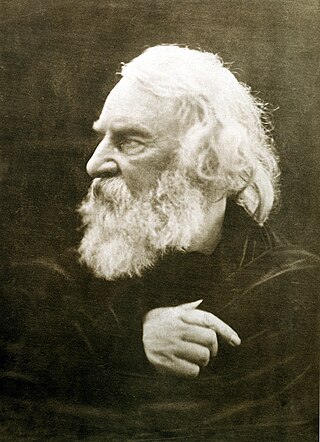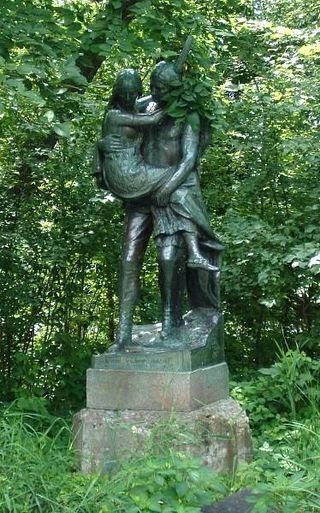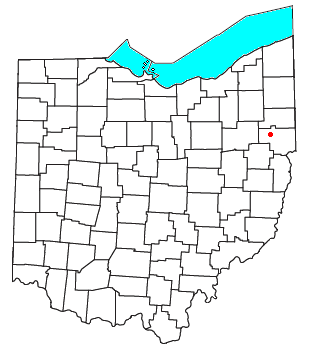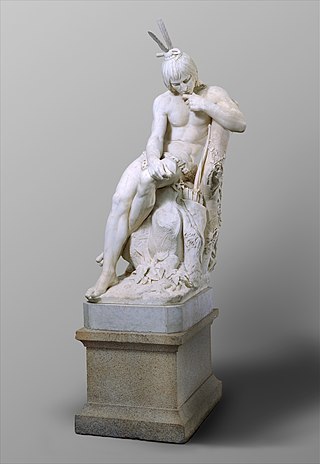Related Research Articles

Henry Wadsworth Longfellow was an American poet and educator. His original works include "Paul Revere's Ride", The Song of Hiawatha, and Evangeline. He was the first American to completely translate Dante Alighieri's Divine Comedy and was one of the fireside poets from New England.

Hiawatha, also known as Ayenwatha or Aiionwatha, was a precolonial Native American leader and co-founder of the Iroquois Confederacy. He was a leader of the Onondaga people, the Mohawk people, or both. According to some accounts, he was born an Onondaga but adopted into the Mohawks.

The Song of Hiawatha is an 1855 epic poem in trochaic tetrameter by Henry Wadsworth Longfellow which features Native American characters. The epic relates the fictional adventures of an Ojibwe warrior named Hiawatha and the tragedy of his love for Minnehaha, a Dakota woman. Events in the story are set in the Pictured Rocks area of Michigan on the south shore of Lake Superior. Longfellow's poem is based on oral traditions surrounding the figure of Manabozho, but it also contains his own innovations.
Hiawatha (Haiëñ'wa'tha) is a Native American semi-historical figure who was the co-founder of the Iroquois Confederacy.

Guido Pieter Theodorus Josephus Gezelle was an influential writer and poet and a Roman Catholic priest from Belgium. He is famous for the use of the West Flemish dialect.

Minnehaha is a Native American woman documented in Henry Wadsworth Longfellow's 1855 epic poem The Song of Hiawatha. She is the lover of the titular protagonist Hiawatha and comes to a tragic end. The name, often said to mean "laughing water", literally translates to "waterfall" or "rapid water" in Dakota.
Hiawatha's Rabbit Hunt is a 1941 Merrie Melodies cartoon directed by Friz Freleng. Mel Blanc voiced all characters. This film was nominated for the Academy Award for Best Short Subject (cartoons). This was the first Bugs Bunny cartoon directed by Friz Freleng. The short makes several direct references to The Song of Hiawatha, an epic poem by Henry Wadsworth Longfellow.

Mondawmin is a neighborhood located in the city of Baltimore, Maryland, United States. The neighborhood is surrounded by Druid Hill Park, the Whitelock Community, and Lower Park Heights. Included within its boundaries are Frederick Douglass High School, and Mondawmin Mall. The Baltimore Metro Subway serves the neighborhood, with a station at Mondawmin Mall that is also a hub for many bus routes.

Longfellow is a defined community in Minneapolis, Minnesota which includes five smaller neighborhoods inside of it: Seward, Cooper, Hiawatha, Howe and Longfellow. The community is a mix of agri-industrial properties along the old Northern Pacific Railway, expansive parkland surrounding the famous Minnehaha Falls, and smaller residential areas.

Winona is an unincorporated community in southeastern Butler Township, Columbiana County, Ohio, United States. It has a post office with the ZIP code 44493.
Mondawmin Mall is a three-level shopping mall in West Baltimore, Maryland, United States. The mall was a development of the Mondawmin Corporation, a firm set up in 1952 by James Rouse and Hunter Moss under the Moss-Rouse Company. When it first opened in October 1956, it had an open-air plan and was called the Mondawmin Center. It was later enclosed and renamed the Mondawmin Mall.

"The Death of Minnehaha" was a part of Henry Wadsworth Longfellow's 1855 poem The Song of Hiawatha.

"A Psalm of Life" is a poem written by American writer Henry Wadsworth Longfellow, often subtitled "What the Heart of the Young Man Said to the Psalmist". Longfellow wrote the poem not long after the death of his first wife and while thinking about how to make the best of life. It was first published anonymously in 1838 before being included in a collection of Longfellow's poems the next year. Its inspirational message has made it one of Longfellow's most famous poems.

Hiawatha is a 1952 American Western film based on the 1855 epic poem The Song of Hiawatha by Henry Wadsworth Longfellow, centering on Native Americans in pre-Columbian times. Directed by Kurt Neumann, with stars Vincent Edwards and Yvette Dugay, it became the final feature produced by the low-budget Monogram Pictures, a mainstay of Hollywood's Poverty Row.

M/V Kwasind is a passenger ferry built in 1912 for the Royal Canadian Yacht Club, in Toronto, Ontario, Canada. She is 71 feet (22 m) long. She was built by the Polson Iron Works and cost CA$13,000. Her name was taken from Henry Wadsworth Longfellow's poem about Hiawatha, as the yacht club's previous ferry is Hiawatha.

Hiawatha and Minnehaha is a sculpture by Jacob Fjelde that has stood in Minnehaha Park in Minneapolis since the early twentieth century. Now a popular fixture of the park, its placement there was originally controversial.

Hiawatha is a 1913 American silent drama film directed by Edgar Lewis and based upon Henry Wadsworth Longfellow's epic poem The Song of Hiawatha (1855). The film stars Jesse Cornplanter of the Seneca people and Soon-goot, a 17-year-old unknown actress. The movie is the first feature film to use a cast of Native Americans.
Pugasaing is a Native American dice game played by the Ojibwe. It is mentioned by name in Henry Wadsworth Longfellow's poem, The Song of Hiawatha. The word pugasaing is the participle form of the verb "to throw" in the Ojibwe language.

Hiawatha and Minnehaha are 1868 sculptures by Edmonia Lewis. They are in the collection of the Metropolitan Museum of Art on view in gallery 759.

Hiawatha is a 19th-century sculpture executed in marble by American sculptor Augustus Saint-Gaudens. The work, which depicts the Iroquois leader Hiawatha, is in the collection of the Metropolitan Museum of Art.
References
- ↑ Patricia Turner, Charles Russell Coulter, Dictionary of Ancient Deities p.327
- ↑ Mondamin brand website: corporate history page Archived 2010-04-03 at the Wayback Machine (German)
- ↑ Mondawmin Mall
- ↑ "Mondawmin".